
The Ultimate Invisalign Handbook – Part Two
Hello everyone! I’m Dr. Ella Osborn, coming to you once again from Seaport Smiles in Boston, Massachusetts. Last week I answered some commonly asked questions about Invisalign as well as providing some tips and advice to help you get the most out of your clear aligner treatment. Today I will be answering more of the Invisalign questions that our patients asked most often. So let’s dive right in!
How long do I have to wear my aligners each day?
For the best results, you should wear your aligners at least 20 hours a day, ideally 22. Remember to wash your hands with soap and water before removing your aligners and before putting them back in. When you first take your brand-new aligners out of the package, it’s best practice to give them a little rinse with water before you place them in for the first time.
Do I still need to go to the dentist while I’m doing Invisalign?
Absolutely. Everything is the same. Your oral hygiene is very important so you want to continue to see your dentist and hygienist for cleanings every six months and complete any treatment if any is indicated by your dentist.
How do I take my aligners out and put them back in?
At first, your Invisalign aligners can be a little tight, so we provide you with a special little tool, kind of like a little hook, that is really a big help when you’re getting used to your aligners. When you remove your aligners, you want to start on the inside in the back and use the hook and pull the aligner up a little and away from your teeth. Pull away from the attachments across until it’s removed.
To put your aligners back in, you want to do the opposite and start in the front. Push down and then work your way backwards. When placing your aligners, it’s very, very important to do something called massaging the attachments. Massaging the attachments is critical for the efficacy of your aligners. And what that means is with your thumb and forefinger, quite literally squeeze the teeth, especially those that have attachments, to make sure that they’re locked all the way down. You want to squeeze from the top down to the bottom, past the attachment to the gum line, and really make sure that they’re fully engaged. And you want to do this with very active pressure. We always say that when you’re massaging your attachments, you’re getting a very, very deep tissue massage, not a gentle calming one.
What are Chewies?
To help your aligners do their job, it’s also very important to use something called Chewies. Chewies are little rubbery plastic cylinders that you use to help seal the aligners all the way down. You want to use them every time you put your trays back in, for a few minutes. The best way is to start in the back and work your way across back and forth six times.
Why are Chewies so important for the efficacy and success of your treatment?
Like massaging your attachments, Chewies are important because we want to make sure there are no little gaps between the clear liner and your tooth. If there are gaps, that means the tooth isn’t moving with the tray and we want to make sure we eliminate those gaps right away. That is where Chewies come in.
If you receive a message from us that says to use your Chewies more, it means one or two of the teeth still need a little bit more time to move and Chewies are a perfect way to help seal the tray all the way down so that you can go on to the next aligner and keep going strong in your Invisalign journey.
What does it mean if you get a ‘no go’ from us?
A ‘no go’ just means that your aligners and your teeth need a little bit more time together. Usually, it’s just one or two teeth that need a little extra time in a particular aligner stage. We watch your treatment very closely through our dental monitoring technology and make sure that every tooth is ready to go on to the next aligner.
The back of one of my aligners has come away from my teeth – what do I do?
Every once in a while, the back of the tray comes apart a little bit from the tooth. It has to do with the way Invisalign makes its aligners. There’s nothing wrong with your treatment or your trays. There’s a simple way to fix this. When it happens, it looks something like this, where just won’t sit all the way down.

If this happens to you, all you do is take the tray and bend it quite literally 90 degrees. The Invisalign material is very strong and flexible, so it will not break, but it will bend a little bit to help the trace that all the way down in the back.
Help, my teeth don’t fit together anymore like they used to!
We’re moving your teeth and very often that involves changing your bite to get a better, healthier one that will serve you over the long term. But the process can be challenging. We’re very used to our bites and the way our teeth come together. As we move your teeth, your bite will change and things will feel different. It is very common and expected. Trust the process. If you ever have any questions, we’re always here for you.
Is there a way to make my teeth move faster?
Biology is different from technology, but we do have ways to augment and improve your own biology so that your teeth can either more predictably in cases that are very challenging, or faster. For patients that really want to get done as quickly as possible. PROPEL is a procedure that’s completed in the office under some light local anesthetic, the kind of numbing you get if you have a cavity at the dentist. PROPEL activates the local biology in your mouth, where we make little pokes, and really makes things move a lot more predictably and with less resistance.
What do I do if an attachment comes off?
It’s not uncommon during Invisalign treatment for one of the attachments can pop off a tooth. Sometimes it’s good practice to have it put back on straight away. Sometimes, it’s perfectly fine to wait until your next regular Invisalign appointment to have it replaced. Because we’re always watching you from afar, very often, within a few days at your next scan, we’ll know that you have an attachment off.
You can also always send us an email and let us know. We’ll find out what attachment it is, and then we’ll check against your plan to see if it’s a critical attachment at that moment in time in your treatment, or an attachment we may need later on. So let us know, and we’ll let you know if you need to come in for a quick little appointment, or if you can wait and we can place it at your next visit.
Seaport Smiles is located in Boston, MA, and is the only multi-disciplinary orthodontic and craniofacial surgery practice in New England. They offer a full range of facial plastic surgery, skincare, and orthodontic services.
